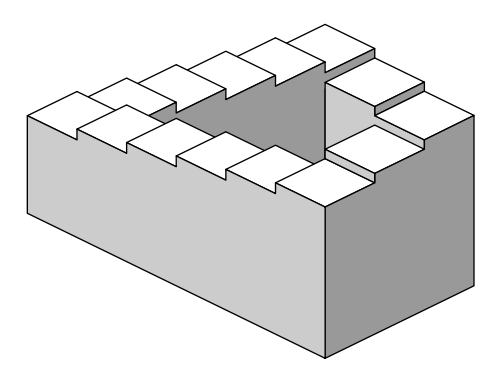
Why do we see this image of the Penrose Stairs as being impossible? Optical illusions, such as this one, and magic tricks function because of at least two structures, perhaps we should call them limitations, related to our perception of reality, namely bodily structures (our sensory system) and conceptual structures )the frameworks around which we organize those perceptions). Considering these limitations becomes important not only for our perception of illusions but also for the work of observation and description that informs much scholarship and public discourse.
These reflections came out of watching David Blaine perform his ice pick trick in a conversation with Neil DeGrasse Tyson with Pharrell Williams and Scott Vener in their OtherTone Studio.
DeGrasse Tyson begins the video above with a discussion of illusions as “brain failures” that come from the “frailties of the human sensory system.” He continues, “Our hubris prevents us from confessing that [brain failures] to ourselves.” Magicians like Blaine, according to DeGrasse Tyson, recognize and exploit the limitations of our ability to perceive the world through our senses.
After Blaine put the ice pick through his hand without creating pain or blood loss, DeGrasse Tyson notes how the expectation that an ice pick through someone’s hand would generate both pain and blood loss, possibly even leaving a mark, becomes the point of contention, the surprise or illusion. While Blaine’s study of the physiology of the hand gives him the knowledge to perform the trick with such a surprising outcome, the disconnect between our expectations and our perceptions pushes us to find an alternative explanation such as identifying the performance as magic.
So, our perception of the reality around us is dependent on both of these structures. We can only perceive what our sensory system is able to process, and we make sense of those perceptions based on the conceptual structures, the expectations that we already have. So, while we say “seeing is believing,” the physical world in which we operate, the activities that we observe—reality (as some would call it)—is only accessible to us through these two structures. This becomes one reason that, whether we describe a historical event or a festival in China, our description is not the reality, as it is filtered through both of these structures. Similarly, when we talk to others, whether we identify them as collaborators, interviewees, or informants, what we hear from them is a description of reality filtered through both of these structures, as well as their agency to represent things to us according to their own interests. The limitations of human perception become one reason why my objective in the classroom is not simply to describe the religions of India or the dynamics of Indian-American experiences. My objective, in a very general sense, is to help students begin to think critically about the construction of the descriptions that we read and hear and the process through which people have constructed them.
Optical Illustion By Sakurambo (Own work) [Public Domain], via Wikimedia Commons

Is magic an optical illusion? Then if the magician goes over water is it also an optical illusion?